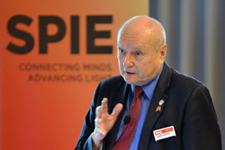 |
Date Announced: 12 Sep 2014
Golden-anniversary year presents college with valuable scholarship-building opportunity
With a long list of valuable contributions to improvements in healthcare, communications, research, and many other fields, the University of Arizona’s College of Optical Sciences this year is celebrating the 50th anniversary of its founding. OSC alumni, faculty, students, staff, and friends celebrated at several events last month during SPIE Optics + Photonics, sponsored by OSC industry affiliate SPIE, the international society for optics and photonics.
BELLINGHAM, Washington, and SAN DIEGO, California, USA — At the recent SPIE Optics + Photonics symposium in San Diego, California, the University of Arizona College of Optical Sciences (OSC) celebrated its golden anniversary. Given the long list of accomplishments noted at the event, it is impressive to realize that OSC is only 50 years old.
The more than 2,400 graduates of OSC and its many talented faculty – including three Nobel Prize winners, Willis Lamb (1955), Nicolaas Bloembergen (1981), and Roy Glauber (2005) – have been responsible for numerous innovations in healthcare, communications, genetic research, space exploration, community safety and national security, and much more.
OSC technologies enable some of the world’s largest telescopes and are found in applications including smart phones, 3D manufacturing systems, imaging systems in consumer cameras, airborne and space systems for defense and scientific exploration, disease diagnosis and treatment, and fiber optics for internet and broadband networks, noted Dean of the College Thomas Koch.
A two-day conference titled Fifty Years of Optical Sciences at the University of Arizona included sessions illustrating the span and expertise of OSC’s research programs:
Presenters included many of the foremost experts in each field, reflecting OSC’s standing as one of the leading optics and photonics schools in the world.
SPIE will publish a special hardcover conference proceedings volume edited by the conference’s distinguished trio of chairs: former OSC director and Regents’ Professor of Radiology, Optics Sciences, and Mathematics Harrison Barrett; OSC professor of Optical Sciences and Ophthalmology John Greivenkamp; and Professor Emeritus of Optical Sciences and Electrical and Computer Engineering Eustace Dereniak.
Dereniak is one of several OSC faculty and alumni who have served as President of SPIE. Others are 2014 President Philip Stahl of NASA, Professor Emeritus Jack Gaskill, and former directors William Wolfe, Robert Shannon, and James Wyant. Another, newly elected 2015 Vice President Glenn Boreman of the University of North Carolina and Plasmonics, Inc., will serve as president in 2017.
Continuing the visionary approach that has helped drive the college from the beginning, OSC is working this year on development of a scholarship program funded through a generous four-to-one matching donation from Wyant, OSC’s first dean. His $10 million matching-fund contribution is expected to fund 25 Friends of Tucson Optics (FoTO) scholarships. The program will offset state funding lost in budget cuts that was particularly important in attracting top first-year graduate students to the college.
Koch announced at a reception during Optics + Photonics that 24 FoTO scholarships have already been funded through donations of at least $100,000 by groups and individuals combined with matching funds. He thanked the donors, many of whom are alumni, and noted that SPIE is unique in being the only professional society funding a scholarship through the FoTO program.
In the opening talk of the OSC conference, Wyant outlined milestones and achievements throughout the tenures of each of OSC's directors and deans, noting how the distinct personalities and talents of each contributed to the college’s development, through challenging times as well as growth spurts.
For example, Aden Meinel, founding director of the original Optical Sciences Center, established OSC in a central location on campus, and the arrangement whereby the center’s director reported directly to the provost, Wyant said.
Meinel and his successors were also very astute in hiring high-quality faculty with a broad range of expertise including industry experience, emphasizing the importance of writing papers and of making hardware, and cultivating interdisciplinary research approaches with other university departments, Wyant said.
It also has actually been an asset to have been underfunded by the state, he noted: "We were forced to get contracts to grow the program." OSC has an extremely robust industry affiliates program, and is responsible for half of the university’s patents.
In his introduction at the conference as well as in remarks during the reception and a luncheon during Optics + Photonics, Koch and others speakers stressed the long-standing close connections between OSC and SPIE. Along with the SPIE presidents, numerous OSC faculty and alumni have served as SPIE Directors and committee chairs, and many more as conference chairs, journal editors, short course instructors, authors, and exhibitors.
E-mail: info@spie.org
Web Site: www.spie.org
| © 2025 SPIE Europe |
|